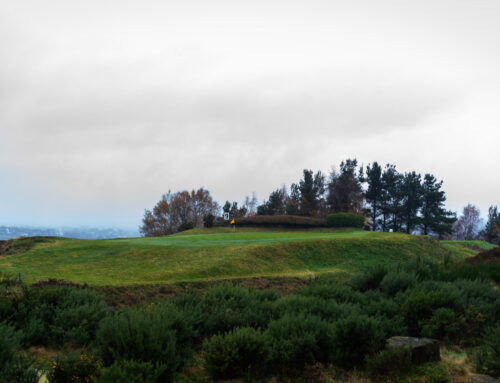
Firstly – Why do we need another newsletter?
Perhaps it’s true that golf has always had an image problem and in the year 2021 it’s tempting to think the game is at a crossroads. Over the last year we’ve heard animated debates about a range of topics, all of which seem to relate to the very spirit of the game: the distance the ball is travelling, classic courses becoming obsolete, prize funds, choices of sponsor, pace of play, flexible memberships, hoodies and dress codes…
We’re firm believers that one of golf’s great strengths is that there is space for different approaches. There’s no reason why pay-and-play courses with relaxed dress codes can’t coexist with more traditional clubs where the staple diet is foursomes matchplay under two hours. The growing number of indoor simulators and TopGolf venues in bustling cities also have much to offer, both for the time-strapped young professionals who want to hone their game before the Saturday medal, and for those who are new to the sport.
But it seems that many of the current commentators and ‘influencers’ are seeking revolution, rather than gradual, steady progress. In addition, it’s become abundantly clear that punchy news headlines and 280-character tweets can never capture the nuances that are central to these debates.
We’ve been fortunate to spend some time at a range of clubs in the UK whilst filming our Story of a Golf Club series, from small clubs like Cleeve Hill to historic Open Championship venues like Royal Liverpool, and the most exclusive clubs like Renaissance. Sunrise drone footage aside, the most enjoyable part of producing these films has been spending time with the members of these clubs, and learning about their history and quirks which make each one unique.
And ultimately, that’s our goal with Cookie Jar Golf – sharing what we believe to be the most important and interesting stories in the sport, in a way that is exciting and engaging, and we hope this newsletter will follow in a similar vein… (full foreword here)
So… should golf be more Disney?
No, we don’t mean a franchise of retail stores selling cuddly toys resembling Rory McIlroy or Sungjae Im, nor do we mean cartoons depicting the latest exploits of a villainous Patrick Reed caricature. Instead, we’re referring to the words of the world-renowned golf historian David Normoyle, who joined the podcast this week to talk about the legacy of Arnold Palmer, and golf history more generally…
We are now at that stage in the professional calendar where things seem to matter more. More FedEx and OWGR points up for grabs, and events held at more prestigious venues. Personally, I’ve found it hard to get excited about the Waste Management Phoenix Open and it’s half-filled stadia, nor a wrap-around season played on freshly built 7,600 yard courses.
But recent events at historic places such as Pebble Beach, Riviera and, this week, Bay Hill for the Arnold Palmer Invitational give us the chance to celebrate some of the greatest moments in the game. And this is where David takes us on the pod, as he talks about making these stories more accessible to a wider audience, especially in the context of Arnold Palmer.
David makes the point that the legacy of certain figures and moments in the game are never assured – they must be continuously shared and reimagined, particularly for younger generations. Disney doesn’t spend any time or resources on marketing their characters and stories to 30 year olds, because they’ve already captured our hearts during childhood.
Bobby Jones is a brilliant example of how this has been achieved. During the late 50s and 60s, when The Masters’ place as one of the four majors was far from set in stone, many in golf failed to recall Jones’ achievements as a competitor, and could only see him as a frail man. Yet today, we see him as the patron saint of The Masters, the most accomplished player of his generation, and a vibrant figure who could teach Hollywood stars how to play the game in a cool, fashionable way.
The passage of time since Jones’ death in 1971 has, naturally, reinvigorated his legacy. But this alone hasn’t been sufficient – the care and attention paid by Augusta National Golf Club and historians such as Sidney Matthew in retelling Jones’ stories are what brings the legend to life again.
Nowadays, I feel that golf is quick to shy away from sharing some of its proudest moments in the never ending quest to ‘grow the game’, instead choosing to focus on the latest advances in clubs or gimmicks like shot tracer. Too-often commentary teams just pay lip-service to historic figures, places and events, and many will readily talk about what golf should be, rather than celebrating what golf is and where the sport has come from. People are only too quick to lambast clubs for their idiosyncrasies, without first understanding their history.
This isn’t to say any of these people are wrong – many developments in recent years have rightly been lauded as progress. But perhaps there is an imbalance – the sport appears too nervous to celebrate all that has been great in the past…
If we parked those fears and gave Disney the keys to the golfing-kingdom today, with all of the resources at its disposal, what could be achieved?
Theme parks and digitally animated films might be a stretch, but they would almost certainly look to secure a stake in new and innovative technology that allows them to better showcase all aspects of the game in a fresh and unique way to a different audience. They would take on fledgling franchises and give them a bigger platform, and combine them with feature events to help diversify and broaden the audience.
This is no doubt something Mike Whan will bring to the USGA following his successful tenure on the LPGA, where he oversaw the increase in scheduled events and prize purses, as well as an unprecedented change in the level of broadcasting. The benefits from this at a grass roots level are clear – during Whan’s tenure the number of girls enrolled in the USGA Girls Golf Programme soared from 5,000 to a staggering 90,000.
In the future, professional golf will naturally start to incorporate more innovative approaches to tournament staging, with better mobile content, 3D mapping and a more immersive viewer experience. However, it’s important we don’t only look forward with this new-fangled technology, but also think about how the same constructs can be used to look back in time and celebrate the most significant people and places in our sport.
Seeing the exciting work by companies like Evalu18 in their 3D mapping, elevating the role that history has played in course evolution, or listening to orators like Mike Clayton and even Sky Sports with their ‘Open For The Ages’ broadcast last year are only starting to scratch the surface with where this could go.
Whilst there are passionate souls all over the globe doing these things in pockets, the greatest (but most rewarding) challenge for us all is to retell these important stories and legacies in a way that is captivating and inspiring for a bigger and broader audience.
Words by Sam

New & Interesting
Latest Merch

Both the Pick’n’Mix and the Choc Chip Cookie Jar Tees are noe available through our mechendise store.






